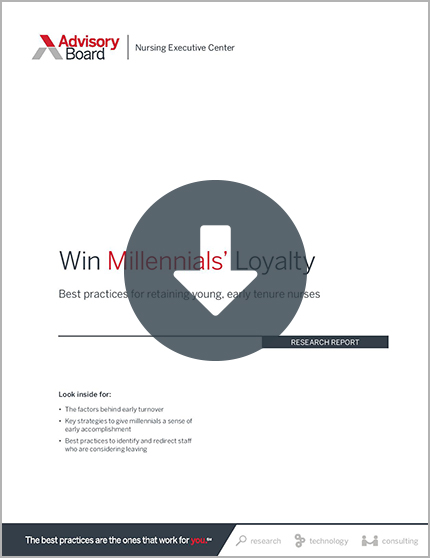Auto logout in seconds.
Continue LogoutEditor's note: This story was updated on Feb. 8.
Read Advisory Board's take: Why organizations shouldn't just relying on raising wages for enagagement
Some health systems are taking a counterintuitive approach to trimming expenses: spending more now to raise minimum wages in the hopes of reducing turnover costs and saving money in the long term, Alex Kacik reports for Modern Healthcare.
A different approach
Wages and benefits make up about 50% of providers' expenses, and they're typically the first to be cut when executives look to trim costs, Kacik reports.
But that's starting to change, as more and more health systems realize the hidden cost of turnover. According to Kacik, staff turnover can get pricey for health systems, given the costs of temporary staff, and the overtime and strain placed on employees who take on extra work until a new hire is found.
As such, hospitals are investing millions of dollars into employee wages, with the expectation that a higher base wage will improve employee retention, efficiency, and quality, and therefore save money over time, Kacik reports.
At least 13 health systems have announced that they are increasing their minimum hourly wage by 2021. Of those 13, seven—including Cooper University Health Care, Duke University Health System, Jefferson Health, and Trinity Health facilities in Pennsylvania, Delaware, and New Jersey—are increasing their minimum hourly wage to $15 this year. The move comes as more major cities and large companies are moving toward a $15 minimum wage.
Advocate Aurora Health, Atrium Health, Cleveland Clinic, and UPMC, have already begun increasing base wages. Several of those health systems plan to raise their minimum wage to $15 in the future.
How one system made the wage hike work
Atrium decided to invest $7.7 million in base wages when it saw turnover rates for minimum-wage workers and nurses rise to about 20% and between 10 and 12%, respectively.
The investment allowed Atrium to increase hourly wages from $11.50 to a minimum of $12.50 for more than 16,500 employees. While Atrium had to make a hefty initial investment to implement the wage increase, executives predict that the change will improve the system's margin down the line, according to Scott Laws, VP of total rewards at Atrium Health.
"Stabilizing the workforce through minimum wage increases and some career advancement programs are actually saving us money because the churn and cost of managing turnover is higher than the cost of investing in these programs," Laws said. "We are investing in these supporting roles. But if we don't, the turn and churn absolutely impact more direct patient-facing roles."
Making it work in other settings
However, minimum wage hikes may not be an option at smaller hospitals and health systems that operate on lower revenues, according to Kenneth Hertz, principal consultant with the Medical Group Management Association's Health Care Consulting Group. "If reimbursement continues to go down and organizations continue to have revenue issues, then salary increases like this are going to severely exacerbate the problem," he said.
Instead of increasing the minimum wage, smaller hospitals can remain competitive and therefore retain more employees by offering improved benefits or more flexible schedules, Hertz said.
Guadalupe County Hospital in New Mexico, took a different approach, and changed its entire pay structure by "drawing from proposed top-tier or executive level pay increases to fund the lowest tiers," according to Christina Campos, administrator for the hospital. "It's a zero-sum initiative, which benefits the lower levels a lot more than it hurts the top," she said.
But, as wage increases continue to gain traction across hospital systems that hope to improve their bottom line, Hertz emphasized that higher wages "won't keep people for the long term." Ultimately, hospitals have to offer other benefits and values to keep employees engaged and improve the bottom line, he said (Kacik, Modern Healthcare, 1/26).
Advisory Board's take
 Carol Boston-Fleischhauer, JD, MS, BSN, Chief Nursing Officer and Managing Director
Carol Boston-Fleischhauer, JD, MS, BSN, Chief Nursing Officer and Managing Director
As this story mentions, offering competitive wages is an important aspect of employee—and particularly nurse—engagement. However, organizations are cautioned to not over rely on a competitive salary structure as their primary engagement strategy. To truly engage nurses, organizations need to go beyond traditional engagement strategies and focus on several key drivers of engagement.
Our research looked at our National Engagement Database, which includes the responses of over 300,000 respondents, and isolated several main dimensions of engagement which have the greatest running room for improving engagement. Here are five pressure-tested best practices for advancing each dimension:
- Translate market forces and executive-level decisions to frontline staff. Many nurses report that they don't understand the market rationale for executive-level actions, which can lead them to feel like executives don't understand them—and create a sense of disconnection from the organization. To address this, executives need to create forums (such as town hall meetings) to communicate market forces to staff and help them understand how broad, organizational changes impact their daily work.
- Listen to frontline staff ideas—but channel them to areas where the organizations most needs their input. Frontline staff want to know that their ideas are being solicited and heard, but it is often time-consuming and unrealistic for executives to read over and respond to every suggestion. Instead, organizations need to create clear venues for staff to submit their ideas which are focused around core organizational challenges, thus creating the greatest chance at finding quality, actionable ideas.
-
“Staff are most likely to remain at organizations where they see a clear career path forward”
- Build meaningful recognition into leaders' workflow. Staff want to be recognized for their hard work and accomplishments, and managers often understand the importance of recognizing them. However, managers are often too busy to add recognition to their regular workload, which can often result in attempts at recognition not being as professional meaningful as they could be. Helping build regular recognition into managers' workflows can help fix this problem, by making recognition a hard-wired task, and creating time for managers to make it meaningful (like being able to link it to specific accomplishments and delivering it promptly following the achievement).
- Broaden access to career development opportunities. Staff are most likely to remain at organizations where they see a clear career path forward, but many nurses noted on their engagement surveys that they perceived limited career opportunities or options for meaningful growth. Organizations can address this challenge by broadening options for professional growth (like letting nurses conduct meaningful research or teach skills to younger nurses). They can also make an effort to identify internal candidates for hard-to-fill specialty positions and proactively train them to take on these roles.
- Finally, focus on building resilience. Statistics affirm increased employee concern with the stressful pace of the work environment and increasing concerns about workplace violence; both of which can erode an employee's resilience. As resilience erodes, so will engagement. Steps need to be taken to ensure that the work environment is safe 24/7, and direct action is taken to manage workplace stress in order to avoid staff burnout.
At the end of the day, organizations must continue to be market competitive with wages, but should view salaries as a threshold for RN recruitment and retention—not as the ultimate solution.
Member executives are urged to arrange for Advisory Board faculty to work with your teams directly and present these research studies as well as to follow up with action planning in order to ensure the advancement of a solid engagement strategy for your entire nursing enterprise. To learn more about our onsite service, click here.
In the meantime, be sure to download our research reports to learn much more about how to improve nurse engagement, build millennial loyalty, and manage workplace stress to reduce burnout.
Improve EngagementBuild Millennial LoyaltyReduce Nurse Burnout
Don't miss out on the latest Advisory Board insights
Create your free account to access 1 resource, including the latest research and webinars.
Want access without creating an account?
You have 1 free members-only resource remaining this month.
1 free members-only resources remaining
1 free members-only resources remaining
You've reached your limit of free insights
Become a member to access all of Advisory Board's resources, events, and experts
Never miss out on the latest innovative health care content tailored to you.
Benefits include:
You've reached your limit of free insights
Become a member to access all of Advisory Board's resources, events, and experts
Never miss out on the latest innovative health care content tailored to you.
Benefits include:
This content is available through your Curated Research partnership with Advisory Board. Click on ‘view this resource’ to read the full piece
Email ask@advisory.com to learn more
Click on ‘Become a Member’ to learn about the benefits of a Full-Access partnership with Advisory Board
Never miss out on the latest innovative health care content tailored to you.
Benefits Include:
This is for members only. Learn more.
Click on ‘Become a Member’ to learn about the benefits of a Full-Access partnership with Advisory Board
Never miss out on the latest innovative health care content tailored to you.

